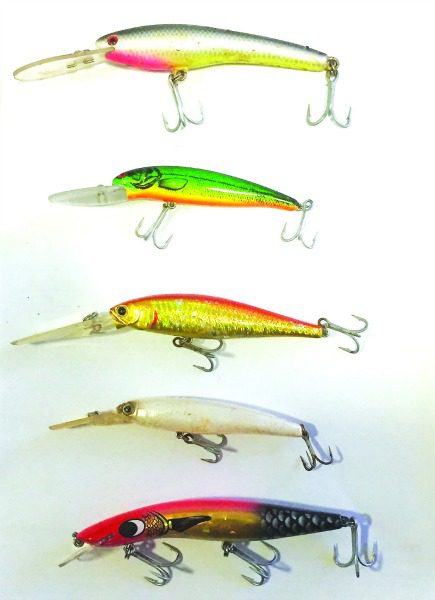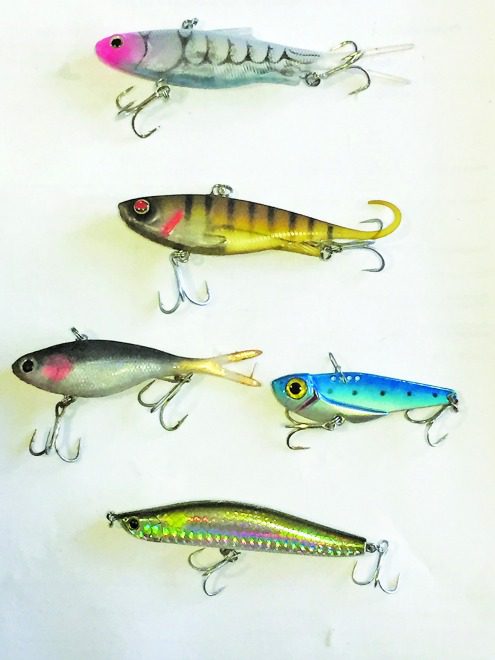AUGUST might be the last month of winter but the days are getting longer and the average daytime temperature is on the rise.
While this is still a great time to chase winter species such as salmon, grunter and bream, my mind is beginning to wander towards summer species such as barra and jacks. This month and next I will go over the techniques and locations that work for me when targeting fish as the weather warms.
Lures
I am going to break lures into four different categories: hard-bodies, soft plastics, vibes and surface. Hard-bodies are tried and tested when it comes to chasing barra and jacks and they are now available in a huge array of styles, colours, shapes, depths and sizes.
Choosing a lure that will get down to the depth of the structure and fish in the area is important. If you are casting these lures you may need to fish with a lure that runs deeper than the water you’re fishing. Typically, if you’re fishing around structure about 3m below the surface, I would use a lure that can dive to 4-4.5m.
Cast lures don’t reach their full swimming depth, so using a lure that can dive deeper means it will get down quicker and spend more time in the strike zone.
Deciding if you want to use a floating, suspending or slow-sinking lure will also depend on the structure you’re fishing. If fishing around dense timber you may want to use a floating lure so you can let it float over branches and reduce the number of snags.
A suspending lure can also be used here. You will get more snags but a suspending lure can give you more time to work the lure in the fish’s face. Using suspended lures around lay-down timber where you are working along the timber rather than through it can be advantageous. They also work well around rock bars and bridges because they can be fished slower and worked more erratically.
If you’re trolling, your lure will be able to reach its full diving depth or deeper by using braided line and trolling with the current. I prefer to troll with the rod in my hand because I can feel what the lure is doing. If it snags, I can drop the rod back or free spool the reel and it may allow the lure to float off.
Trolling also lets you target fish in water up to 10m deep. This can be helpful when fish are schooled around deeper holes. I use a slightly heavier rod when trolling to help absorb some of the shock, especially when trolling a large lure for big barra.
When it comes to hard-bodies, I tend to stick between 75-100mm for jacks and 90-110mm for barra but will use anything up to 150mm when targeting bigger barra. My preferred lures include Marias, Lucky Crafts, Bombers, Lethal Lures, Tilsan Barras and Classic Barras.
Soft plastics are nothing new but have become more commonly used than they used to be. They allow you to cover the entire water column by simply changing the weight of the jig head, or they can be rigged weedless and fished deep into cover.
You are able to buy them pre-rigged on jig heads and the Squidgies range is one of the most popular. These plastics have been used widely in dam fishing for barra, with some people modifying them by adjusting the weight, trimming the plastic, softening the plastic and adding stinger hooks.
Being able to vertically jig a plastic through schools of fish and over deep structure allows you to keep in contact with your lure and will see you catching more fish than you miss. So many different styles of plastic are available, including everything from crab and shrimp profiles to every fish shape you can think of and plenty in between.
I tend to stick with the more common styles such as paddle tails, curly tails, jerk baits and the odd prawn imitation. In terms of prawn-style lures, I mainly use Prawnstars. These are a cross between a hard and soft plastic and work extremely well.





Vibration lures are designed more for targeting schooled fish in deeper water but they are often used to fish shallower structure. Due to their weight, when fishing them around timber and rocks you will need to keep them off the bottom and moving faster to stop them from snagging.
Vibes play an important role in your lure arsenal, allowing you to fish faster current and deeper water and also getting shut-down fish to bite. Vertical jigging is the best way to fish these lures. Stay in contact as the lure drops to the bottom and don’t let it drag along the bottom because the exposed hooks will soon get caught on something.
Choosing a vibe depends on a few things. The weight you need will depend on water depth and current, and size will depend on the size of fish you’re chasing and the size of bait they’re feeding on. There’s also the option of using hard, metal or soft vibes. All will work at different times. I don’t use too many hard vibes and generally stick to the soft vibes such as Samaki Vibelicious, Threadybusters and Zerek Fish Traps.
Surface lures can present an exciting way to target fish and it’s super impressive when you see a barra inhale a lure off the surface. If you see the hit, you need to resist striking because the way barra feed means you will pull the lure away from the fish before the hooks find their mark.
Three styles of surface lure make up the majority on offer. Poppers are the main style but you can also buy fizzers and stickbaits. Poppers and fizzers are worked in the same way and both make noise to attract fish by imitating an injured baitfish. A slow retrieve while working the rod with a small jerking action to get the lure to dart around and make noise works best.
Stickbaits don’t make noise as they are worked across the surface, instead relying on rod action to impart a zig-zag motion. When chasing trevally and queenfish your lure will need to be cranked fast across the surface, however when targeting barra on surface a slow retrieve with long pauses works best.
Soft plastics are now being used for surface fishing too, with some brands making lures just for this purpose such as frogs and Z-Man Pop ShadZ but you can also use a standard soft plastic with little to no weight. I am sure I have missed other lures and options; these are just some of the more common ones that will consistently catch fish.
Nothing beats time on the water and trying different techniques and lures to see what works best in what situation. Next month I will talk rods and reels, what to look for in a fishing location, tides, bait fishing and terminal tackle.
Cheers and happy fishing from Gladdy.
 Bush ‘n Beach Fishing Magazine Location reports & tips for fishing, boating, camping, kayaking, 4WDing in Queensland and Northern NSW
Bush ‘n Beach Fishing Magazine Location reports & tips for fishing, boating, camping, kayaking, 4WDing in Queensland and Northern NSW









